

-
بررسی آییننامهها و دستورالعملهای برنامه هفتم پیشرفت
-
بررسی عوامل موثر بر افزایش تصادفات و تلفات جادهای و سوانح رانندگی و دادهکاوی تلفات انسانی
-
سازماندهی و بازآرایی فضایی آموزش عالی کشور
-
به روز رسانی سند ملی آمایش سرزمین
-
انجام مطالعات مناطق آزاد به عنوان نواحی پیشران اقتصادی کشور
-
اصلاح ساختار بودجه و پیاده سازی نظام یکپارچه مدیریت اطلاعات مالی دولت (IFMIS)

In this meeting, Mohammad Ghasemi, Deputy for Policy-Making and National and Regional Development Steering of the Plan and Budget Organization of the Islamic Republic of Iran (BPO), served as the scientific chair, and Alaeddin Azvaji, Head of Macroeconomic Affairs of the PBO, participated as the keynote speaker, presenting their viewpoints.
At the beginning of the meeting, Mohammad Ghasemi, Deputy for Policy-Making and National and Regional Development Steering of the PBO and the scientific chair of the meeting, stated: “For years, economic themes have been designated as the slogan of the year by the Supreme Leader of the Islamic Republic of Iran, Ayatollah Khamenei. The Supreme Leader himself has emphasized that these slogans are not necessarily limited to a one-year timeframe, but rather signify a prioritization of the government’s overall activities.”
Mohammad Ghasemi further stated: “Following the announcement of the Year’s Slogan by the Supreme Leader as 'Investment for Production,' the government commenced its related activities as of the first day of Farvardin (March, 29th). From the outset, the First Vice Presidential Administration of Iran prepared a work agenda on this subject. The framework for governmental action was communicated by the PBO to the relevant institutions, and in the early days of the Iranian New Year, the views of various organizations were collected in multiple meetings. Due to the importance of the issue, 'Investment for Production' was discussed in the very first meeting of the Cabinet. During that meeting, the President proposed that government agencies be given the opportunity to present their recommendations on the key strategies for realizing the Year’s Slogan.”
As the meeting proceeded, Alaeddin Azvaji, Head of Macroeconomic Affairs of the PBO, speaking as the meeting’s keynote speaker, referred to the remarks of the Supreme Leader on the occasion of Nowruz 1404 and the designation of the Year’s Slogan as “Investment for Production.” He stated: “When the economy is in a stable condition, economic actors engage in real and productive investment activities. Conversely, in situations marked by uncertainty, a segment of economic actors, alongside households, tend to direct their capital toward non-productive assets. Therefore, if we aim to channel public investment toward productive sectors, it is essential to first establish an atmosphere of confidence and macroeconomic stability.”
Alaeddin Azvaji further identified several key obstacles hindering production, including macroeconomic instability, high inflation rates, insufficient liquidity for production, foreign sanctions, the attractiveness of non-productive markets, dual exchange rates, and the lack of foreign investment.
He added that evidence from the Iranian economy indicates that during periods of heightened instability and uncertainty, returns on assets have exceeded those of productive investments. As a result, capital resources are less likely to be directed toward productive activities.
The Head of Macroeconomic Affairs of the PBO identified policies such as foreign exchange policy, trade policy, monetary policy, credit policy, budgetary policy, and investment policy as among the government's key strategies for the year 1404 (2025). He emphasized that these policies are critically important for controlling inflation, promoting investment, and fostering economic growth.
Alaeddin Azvaji, addressing the issue of investment financing required for the year 1404 (2025), stated that according to the approved investment financing plan within the framework of Iran’s Seventh Development Plan—particularly for the year 1404 (2025)—and as endorsed by the Supreme Council for the Steering of Iran’s Seventh Development Plan, the total investment required to achieve the economic growth targets for 1404 is estimated at approximately 7,984 trillion tomans. It is projected that a maximum of around 4,715 trillion tomans of this amount will be financed through five main sources.
He continued: To achieve the investment goals of Iran’s Seventh Development Plan, over 3,269 trillion tomans, equivalent to 41% of the total required investment, will be financed through alternative funding methods. The amount of 4,715 trillion tomans, under optimistic assumptions and assuming no leakage to other non-productive sectors, is capable of mobilizing at most half of the investment needed to support an 8% economic growth target.
The Head of Macroeconomic Affairs of the PBO explained that, given Iran's current economic conditions and in order to achieve the objectives outlined in the Year’s Slogan, key principles guiding the government's planning include a focus on productive investment, avoidance of unnecessary government intervention, reduction of risks and uncertainties, promotion of transparency and economic stability, economic justice, balanced development, and sustainable growth.
Referring to the implementation of the “Production and Infrastructure Financing Act,” Alaeddin Azvaji stated that the enforcement of this law—passed by the Islamic Consultative Assembly (ICA) on March 12, 2024, and officially communicated by the Presidential Infrastructure Office on May 6, 2025—assigns various regulatory responsibilities and mandates to the Iranian Council for Financing. In line with this legislation, the Center for Facilitating Production Financing has been established within the Ministry of Economic Affairs and Finance. Additionally, the PBO has been tasked with several key responsibilities, particularly in the area of public-private partnerships (PPP), for which the relevant guidelines have already been approved by the ICA.
Azvaji further stated that from spring 2024 until April 2025, a total of 13 meetings of the Iranian Council for Financing were held at the Ministry of Economic Affairs and Finance (with more than one meeting per month). By the end of 1403 (2024- early 2025), 85% of the legislative drafts had been developed, reviewed, approved, or finalized. Out of the total regulations stipulated in the law, 160—equivalent to 64%—were approved by the Iranian Council for Financing and subsequently submitted to the Cabinet of Ministers for approval. Additionally, six of the remaining nine regulations have already been drafted and will soon be reviewed by the Council's specialized committees and, upon approval, forwarded to the Cabinet for final endorsement.
In the proceedings of the meeting, Mohammad Ghasemi, Deputy for Policy-Making and National and Regional Development Steering of the PBO, summarized the discussions by stating: “If we move beyond the illusionary economic approaches that exist within Iran’s economic framework, we must conclude that investment occurs where there is saving, and saving occurs where production exceeds consumption. This is one of the most complex issues in the field of economics. What has happened in Iran is that, due to oil revenues, the country enjoyed substantial surplus income from production. Therefore, when the ratio of savings to production increases, the conditions for investment effectively emerge.”
He continued: “After the 2000s, following the promulgation of the general policies of Article 44 of the Constitution and the improper implementation of these policies within Iran, the domestic investment came to a halt. Furthermore, with the imposition of unjust sanctions against Iran, foreign investment—also came to a halt. The continuation of these issues to the present day has led to the consequences of such misguided policies, including electricity shortages, gas shortages, and other related problems.”
Addressing the question of what must be done under the current circumstances, Mohammad Ghasemi explained: “From the early days of the current administration, it was emphasized that the country requires a four-year economic plan, which must be operationalized within the framework of Iran’s Seventh Development Plan. As a result, a program entitled “Growth Enhancement” was formulated, involving three key institutions: the Ministry of Economic Affairs and Finance, the PBO, and the Central Bank of Iran.
This program stated that if the current economic trend continues—and assuming no intensification of sanctions—economic growth would reach a maximum of only three percent throughout Iran’s Seventh Development Plan. Therefore, a fundamental transformation in the economic domain is required. This led to the development of a comprehensive program consisting of five main components, with “economic stability” identified as the foremost and most critical priority in Iran’s economic landscape. The subsequent priorities include: economic growth, resolution of energy sector imbalances, reform of Iran’s welfare system, and implementation of high-impact development projects.”
The Deputy for Policy-Making and National and Regional Development of the PBO further stated: “The second ongoing initiative involves the establishment of a task force in collaboration with the First Deputy of the Judicial System of the Islamic Republic of Iran, the President of the PBO, the Ministry of Justice, and the Iran Chamber of Commerce, Industries, Mines and Agriculture. This task force is currently engaged in formulating policies aimed at strengthening the role and share of the private sector in the Iranian economy. The objective is to identify and remove key barriers hindering private sector investment within the economic landscape.”
In the proceedings of the meeting, the experts and specialists expressed their viewpoints and posed their questions.
It is noteworthy that this meeting was held on April 15, 2025, both in-person and virtually, with the participation of national and provincial executive agencies, universities, research centers, and think tanks, at the Hossein Azimi Hall located in the CDRF.



